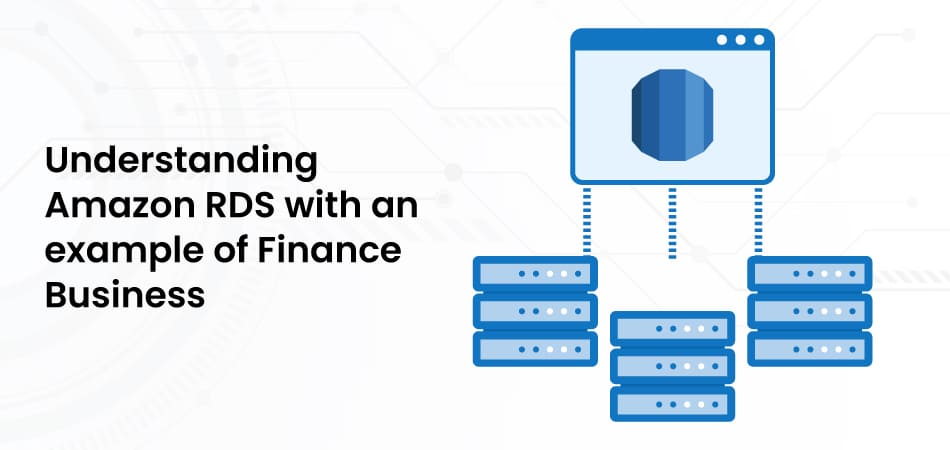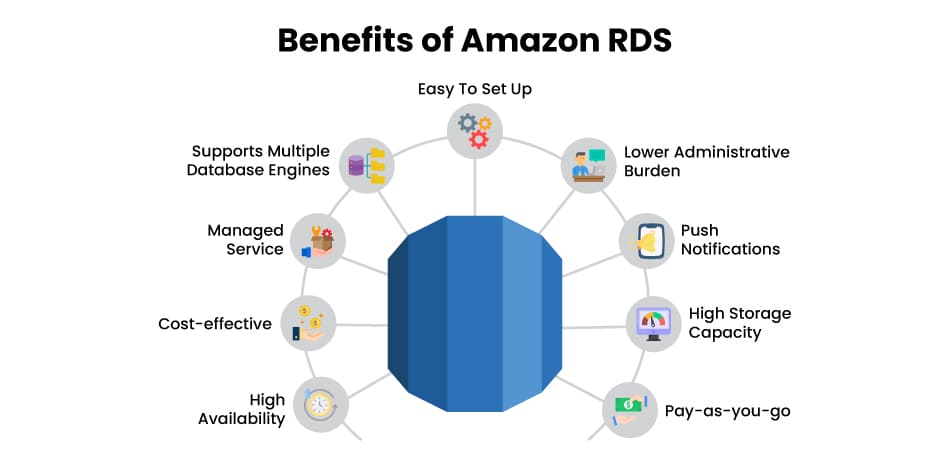We are in an age where data holds significant value, to scale effectively, every business needs to store a lot of data. For this, relational databases are useful to organize data into tables with rows and columns. But, managing them is a challenge. Thanks to Amazon RDS because it makes managing relational databases in the AWS cloud is easy for businesses.
In this discussion, let’s know what Amazon RDS is and why businesses use it to optimize cost and performance.
Table of Contents
ToggleWhat is Amazon RDS?
Amazon Relational Database Service, or RDS, is an easy-to-manage relational database service. This service is unquestionably simple to set up, operate, and scale. A business that is new to RDS can create a new database in a matter of minutes.

An example of AWS RDS is the use of it by a finance management business. That business needs to store the customer’s key financial information so that their customers can view and manage it flawlessly. With the help of AWS RDS, businesses can organize their storage through relational databases that have data stored in multiple tables.
What benefits does a business get from using Amazon RDS?

Businesses prefer AWS RDS because of its specialty in carefully managing relational databases. Undoubtedly, businesses know that enhancing their performances and optimizing their expenses is possible using the AWS RDS, or relational database service. This service has various key offerings, which are given below.
- Easily set up and launch database instances and connect an app within a minute.
- Manage the undifferentiated administrative tasks like software patching, backups, etc., to lower the administrative burden.
- Notify the database of events through emails and SMS using Amazon SNS.
- Enhance availability using Amazon Relational Database Service (RDS) Multi-AZ.
- Businesses only need to pay for the database instance used and delete it after use.
- AWS RDS is compatible with many database engines and can be easily deployed in the cloud or on-premises.
- Amazon’s relational database service allows all businesses to easily manage multiple database instances with the help of the management console.
- AWS RDS is cost-effective for businesses as it follows a pay-as-you-go pricing model.
- Scale your storage capacity up to 64 TiB when required.
Various businesses use Amazon RDS to minimize the complexity associated with managing relational databases. One of the primary benefits of using RDS is that it automates tedious and time-consuming administrative tasks.
What are the use cases for Amazon RDS?
Amazon RDS’s scalability and security make it useful for businesses in various industries to ensure the use of relational databases for a total cost of ownership. A few of the use cases include:
- Amazon Relational Database Service, or RDS, enables developers to build and support web apps with high availability and storage scalability. Backed by AWS RDS, applications are able to handle large amounts of data.
- Build and maintain eCommerce websites by using a secure and reliable method of processing big data. Additionally, it stores a large amount of data to help developers.
- Online gaming platforms can leverage this relational database service to achieve scalability and high performance (two crucial factors in the gaming sector).
- Develop a robust mobile app that is able to store and retrieve vast databases. AWS RDS backs this app to increase its scalability and dependability.
What are the different AWS RDS database engines?
AWS Relational Database Service provides the advantage of flexible pay-as-you-go pricing to suit various business requirements through its database engines, like:
- Amazon Aurora: A fully managed database service available in Amazon RDS and compatible with MySQL and PostgreSQL. It is usually available at 10% of the cost of commercial database engines.
- RDS for PostgreSQL: An open-source relational database that helps to set up scalable PostgreSQL deployments in the cloud. RDS enables developers to manage complex and time-consuming administrative tasks in minutes.
- RDS for MySQL: Renowned for being user-friendly, powerful, and flexible, it is the world’s most-used database management system. It makes it easier to set up and operate MySQL deployments in the cloud.
- RDS for MariaDB: Automate time-consuming administrative tasks and keep your focus only on innovation with the help of Amazon RDS for MariaDB.
- RDS for SQL Server: Scale an SQL server database in the cloud with the help of Amazon RDS for SQL server.
- RDS for Oracle: A fully managed commercial database service that allows developers to operate the Oracle database in the cloud at no extra cost.
- RDS for Db2: A relational database that empowers developers to set up Db2 deployments for large-scale transactional and analytical workloads. Amazon RDS for Db2 is available as a Bring Your Own License (BYOL) model or with on-demand licensing.
Amazon relational database service pricing
Amazon RDS is a managed and secure database service that is available on a free-to-try basis and a business only needs to pay for what is used. Payment can be made either on-demand or in reserved instances and can be calculated through the AWS Pricing calculator.
Conclusion
Simplifying the management of traditional databases, Amazon RDS helps businesses efficiently handle their tools in the cloud. Its compatibility with multiple database engines, including Amazon Aurora, PostgreSQL, MySQL, MariaDB, SQL Server, Oracle, and Db2, offers businesses the flexibility to choose the best solution for their specific needs while benefiting from the scalability and reliability of AWS infrastructure.
 Offer 1 month Unlimited streaming VOD & Live with VideoCrypt Mobile App For Educational institute and Youtube Creators*
Offer 1 month Unlimited streaming VOD & Live with VideoCrypt Mobile App For Educational institute and Youtube Creators*




